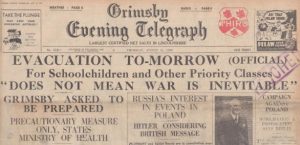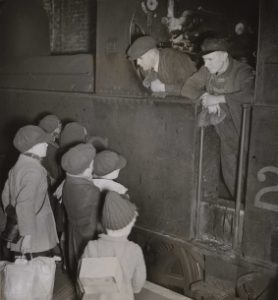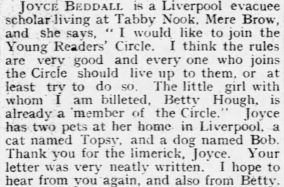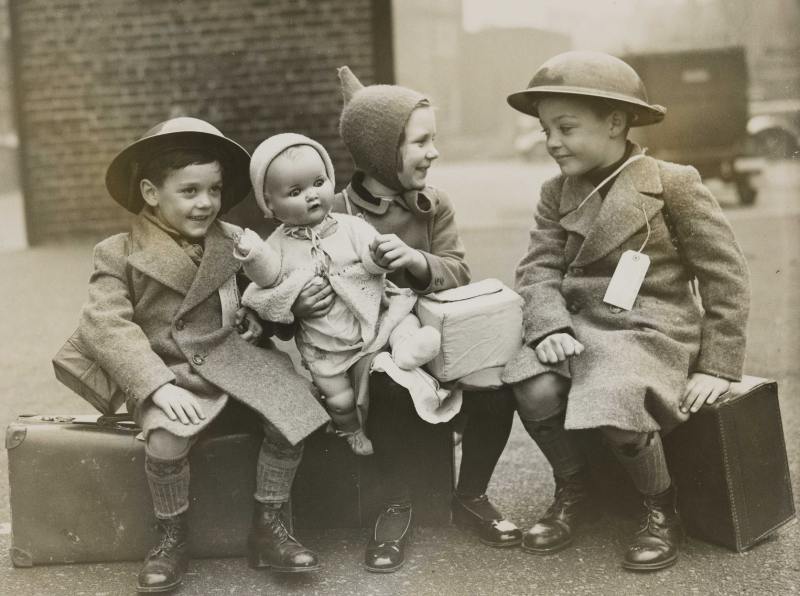Many of us will be familiar with images of WWII evacuee children lined up on train station platforms, luggage in tow, with name tags affixed to their coats, about to head off into the unknown. Their story is an important part of WWII and the home front experience. While researching evacuees is a challenge for family historians, we’ve created a guide to help you learn more about your evacuee ancestors.
War on the horizon
As the storm clouds gathered over Europe in the summer of 1939 and war looked inevitable, it was evident that children and vulnerable people living in the perceived danger areas in Britan would need protecting. The government had been planning an evacuation scheme since the early 1930s, compounded by the advances in aerial bombing capabilities (demonstrated, with devastating impact, by Germany and Italy in the Spanish Civil War of 1936-1939).
News of the evacuation plan was announced via radio and newspapers on 31 August 1939, and the following day, Operation Pied Piper was put into action.

A staggering 1.5 million people were evacuated from towns and cities in industrial centres and shipping targets in the first three days alone; 800,000 of the evacuees were children. They were taken to safer, often rural parts of the country, known as reception areas. Three days into the operation, Britain declared war on Germany, plunging the world into global conflict for the second time in three decades. Participation in the evacuation scheme was not compulsory, and numbers varied across the country; the weight of saying goodbye to children was understandably too much for some.
A personal connection
The evacuee story resonates with me. My grandmother and her brother were evacuated from Southampton in September 1939. Living in the shadow of the docks, they were transferred a short distance along the coast to the safer surroundings of Bournemouth. When the much-feared aerial bombing of British towns and cities failed to materialise, children began to return to their families, including my grandmother and great-uncle. Figures suggest that half of the evacuees had returned home by January 1940 and as many as a million by spring. Evacuations were underway again following the fall of France in June, igniting the fear of invasion, and again with the advent of the Blitz in September.
Through my work at Ancestry, I’ve carried out research into evacuees during WWII, and one project stands out: I helped a former evacuee track down the descendants of the family who looked after him so he could thank them for the care they gave him during the war. This fascinating project prompted me to explore the question: is it possible to research evacuees from WWII? The answer is yes, but it’s far from straightforward.

Researching evacuees: the realities
Sadly for family historians, a database of evacuees does not exist. You’re less likely to find records outlining every step of your evacuee’s journey, like an army service record, naming when they left, where they travelled, who they stayed with and when they returned. You’re more likely to find small clues or pieces of the puzzle. Moreover, records on evacuees are not centralised in one archive like The National Archives (TNA) in Kew. Therefore, we have to go digging – there’s nothing like a challenge for family historians; it’s part of the fun. But where should you start?
Speak to family
It may seem obvious, but speaking to your family is a great place to start your research, whether it’s family history or military genealogy. Ask a family member if anyone was an evacuee during the war (perhaps your family even housed evacuees?) If you’ve asked before, ask again. You may hear a different clue or snippet of information the second time around.
1939 England and Wales Register
If you think you have a WWII evacuee in your family tree, try searching the 1939 Register, available on Ancestry; it’s an important source of information when researching evacuees. The register was taken on 29 September 1939 and is the closest source to a census during WWII. It offers valuable details on households in England and Wales, like a person’s name, date of birth, marital status and occupation. Focusing on the civilian population, the contents of the register were used to create identity cards when rationing was introduced in January 1941 and, in later years, was used by the NHS.
Taken almost a month after Operation Pied Piper launched, you may find the evacuee you are researching within the register. Sometimes the occupation field contains the words’ evacuee’ or ‘at school (evacuee)’. Their occupation entry may state ‘at school’ or contain nothing at all. Ultimately, you’re looking for someone of school age or younger in a separate household from their family, in a different location.

FWR Tip: Living people are censored in the 1939 Register owing to data protection laws. However, you may find that entries for individuals who died recently are still redacted. Ancestry annually adds records for those with birth dates older than 100 years or if a record of the death has been reported to TNA.
The 1939 Register is not available on Forces War Records and requires a separate Ancestry membership to view the images.
School records
When Operation Pied Piper commenced, children assembled at their schools, ready for their onward journey by train, accompanied by their teachers. Evacuees below school age were joined by their mothers or a ‘responsible person’, according to government advice.
Since schools played a leading role in organising evacuees, searching school records for clues is a logical step when researching evacuees. It’s hard to say what has survived; schools may have kept minute books mentioning evacuees or even lists of evacuated pupils. School records are often held at local archives, usually at a county or city level. The archive may have a searchable online catalogue.
FWR Tip: While Ancestry holds a selection of school admission records, none cover WWII, owing to data protection.
What if you don’t know the name of the school your family member attended? This is perfectly understandable, given the name of their school rarely appears in traditional genealogy records. Owing to data protection, school attendance records are not widely available online for this era. With these limitations in mind, try and establish where your family lived in 1939 and research the local schools in the area, starting with the closest school to where they resided. It may help to find their parents in the 1939 Register in order to obtain an address.
FWR Tip: Schools were often recorded on historical maps, many of which can be found online.

Using newspapers to research evacuees and the evacuee experience
Newspapers are a valuable source for researching our ancestors and can offer useful clues to family historians researching evacuees. You may find references to an evacuee or groups of evacuees, giving context to your ancestor’s experience. We discovered articles on sports days and music recitals naming participating evacuees. Who knows what you will find in the extensive collection of British newspapers on Newspapers.com?
Local archives
Records held in local archives helped me solve the case I was researching after I discovered a council minute book naming the evacuee and the family he was residing with. This requires you to know where your evacuee stayed so you can search the relevant local archive or record office. If they have an online catalogue, search with keywords like ‘evacuee’ or ‘evacuees’. You may find evacuee indexes or records containing names. Alternatively, you may be required to think laterally and look in collections which may shed light on evacuees, like council minute books. Content will vary from archive to archive; one collection in a local repository may not exist in another.
For examples of the kind of evacuee records you may find in local archives, explore the following Ancestry collections from Fife and Berkshire, respectively:
Cupar, Fife, Scotland, World War II Evacuation Indexes, 1939-1945
Berkshire, England, World War II Evacuation Records, 1939-1945
Researching evacuees at The National Archives
The National Archives (TNA) in Kew is the official archive and publisher for the UK Government and England and Wales. Their records relating to evacuees may be more relevant to policy or logistics, but it’s worth searching their online catalogue – you never know what you will find until you search. Another advantage of TNA’s catalogue is that it contains entries for records in other archives, helping you to broaden your searches.
FWR Tip: Don’t forget to search the National Library of Wales, the Public Record Office of Northern Ireland and National Records of Scotland.
The British Evacuees Association
The British Evacuees Association is a registered charity dedicated to preserving the story of the evacuations for future generations. While they do not hold records of evacuees, their website may be of interest to former evacuees or to anyone researching evacuees.
Cover image: © Hulton Archive/Getty Images
Sources
Peter Chrisp, Evacuation (Brighton, Sussex, England: University of Sussex Library, 1987). [Online], accessed September 2023.
GOV.UK, Child Evacuees in the Second World War: Operation Pied Piper at 80, accessed September 2023.
Imperial War Museums, The Evacuated Children Of The Second World War, accessed September 2023.


